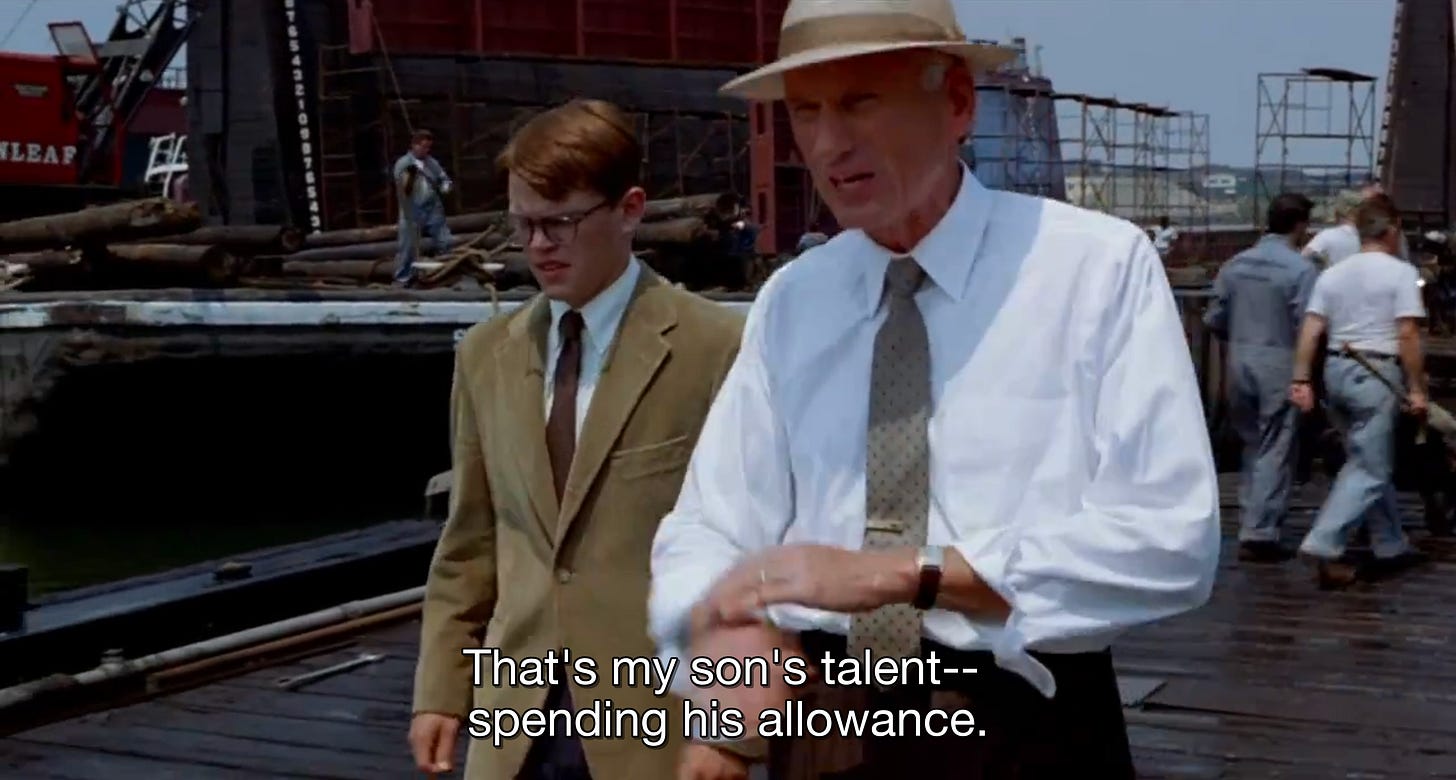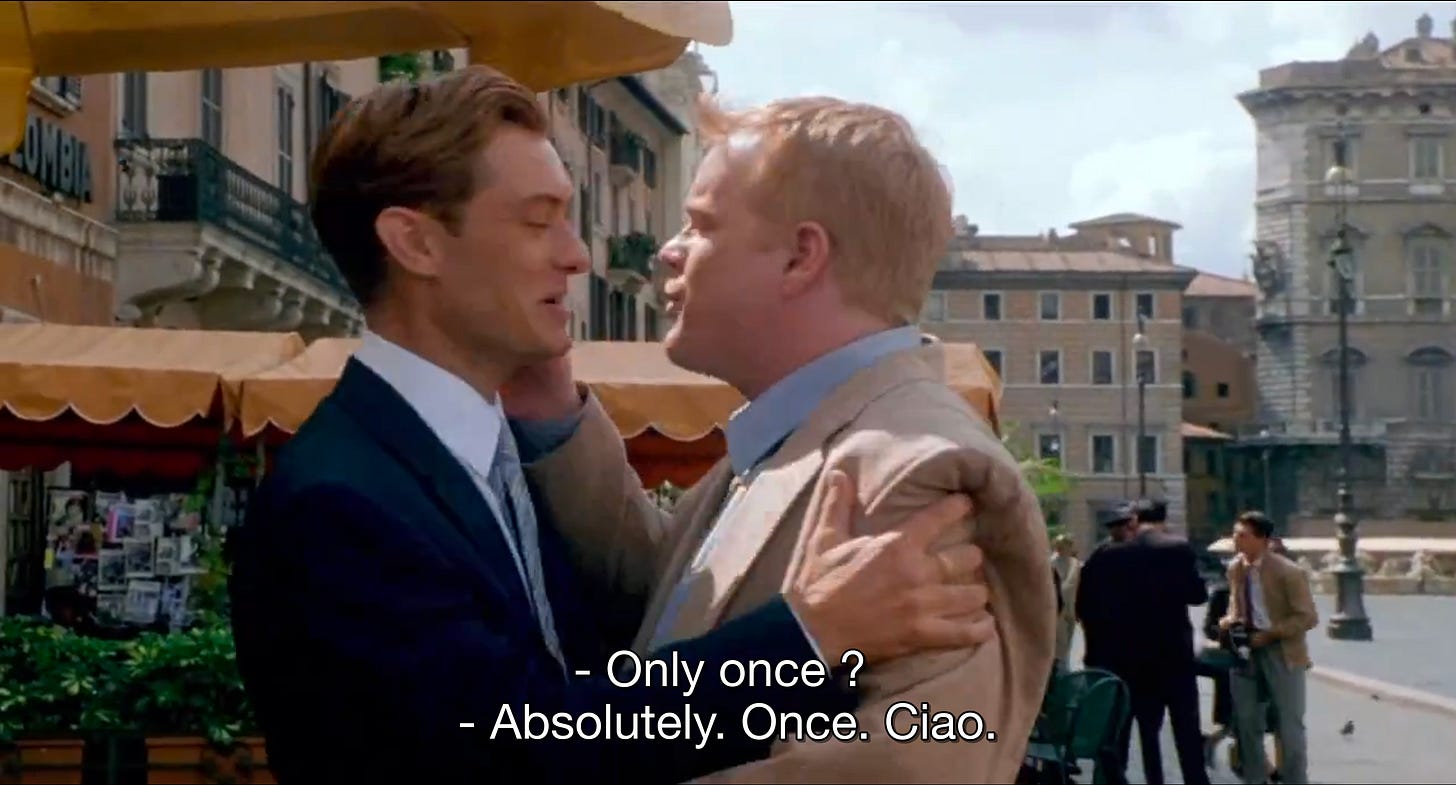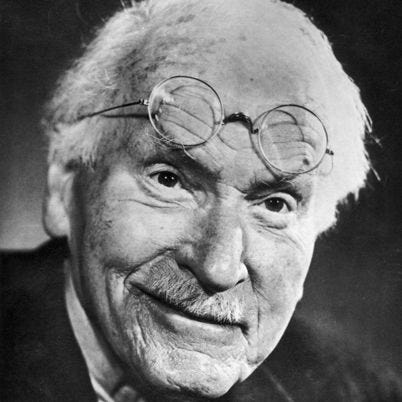The Talented Mr. Ripley: A Study of the Puer Archetype
Viewing the 1999 film through an archetypal lens drawing on the work of Marie Louise Von Franz, James Hillman and Carl Jung.
For any piece of art to have real lasting power, it needs to resonate at the level of the archetypal psyche. This is why the 1999 film The Talented Mr. Ripley will be rewatched and rediscovered by new generations of film lovers long after the recent Netflix series Ripley has been washed downstream in the constant flood of new content.
In contrast to the latest adaptation’s (admittedly stunning) black and white photography, the original Ripley film by director Anthony Minghella is saturated with sun-drenched color and seductive charm.
It features five relatively unknown actors at the peak of their youthful beauty and charisma competing for the viewer’s attention whenever they appear on screen: Matt Damon, Jude Law, Gwyneth Paltrow, Cate Blanchett and Philip Seymour Hoffman.
They all exude a vibrant life force that leaps off the screen and is intoxicating to watch, unlike the dull and flat affect that characterizes the newer Ripley and so many other straight-to-streaming films of the modern era.
If the earlier film is one of the last great examples of the auteur cinema movement that flourished in the 1990s, the recent streamer is an example of what could be called autistic cinema — technically adept but lacking emotional depth.
(Side note: I’m starting to suspect that one of the reasons that movies made for streaming services are focused more on surface-level visual richness rather than emotional/intellectual content is because they so often serve as background noise to other activities or act as a sleep aid.)
At the centre of this star-studded cast is Jude Law as golden boy Dickie Greenleaf, the rich and spoiled son of an American shipping magnate who’d “rather sail boats than build them.”
Dickie is a perfect example of a man identified with what’s known in Jungian circles as the puer aeturnus, or “eternal youth” archetype.
Marie Louise Von Franz, in a seminal text titled The Problem of the Puer Aeternus, writes:
“In general, the man who is identified with the archetype of the puer aeternus remains too long in adolescent psychology; that is, all those characteristics that are normal in a youth of seventeen or eighteen are continued into later life.”
The man possessed by the puer spirit never wants to grow up and become a responsible, dependable adult. His attitude is given voice by the 1960s anthem My Generation’s cry: “I hope I die before I get old.”
Von Franz summarizes this aspect of the puer:
“The one thing he absolutely refuses is responsibility for anything, or to carry the weight of a situation.”
The catalyst for the ensuing drama occurs when Dickie’s father enlists Tom Ripley to travel to the south of Italy where his son has been carrying on a carefree, bohemian lifestyle with his girlfriend Marge (played by Gwyneth Paltrow) in order to convince him to come home and take up the family business.
Father/Son, Old/Young, Senex/Puer
The father-son relationship in TTMR is an insightful dramatization of the split between the puer and senex archetype that plagues our culture. While Dickie perfectly embodies the youthful spirit of the puer, his father carries the weight of it’s other side — the senex or “old man” archetype. If the puer is all about freedom, adventure and spontaneity, the senex holds down responsibility, dependability and consistency.
In my experience, every man needs to deal with this split in himself at some point or risk becoming an old puer. The classic example of the aging puer is the guy you’ll usually find hanging out at the bar in tropical ex-pat communities, regaling anyone who’ll listen with tall tales of their past adventures and haranguing them with their wild conspiracy theories.
If the puer never integrates his senex side, he will face rootlessness, loneliness and excessive death anxiety as his traitorous body ages — that’s if he lasts that long. As Von Franz notes, the puer-possessed man usually meets with an untimely demise.
“The one thing dreaded throughout by such a type of man is to be bound to anything whatever. There is a terrific fear of being pinned down, of entering space and time completely, and of being the singular human being that one is. There is always the fear of being caught in a situation from which it may be impossible to slip out again. Every just-so situation is hell. At the same time, there is a highly symbolic fascination for dangerous sports—particularly flying and mountaineering—so as to get as high as possible, the symbolism being to get away from reality, from the earth, from ordinary life. If this type of complex is very pronounced, many such men die young in airplane crashes and mountaineering accidents.”
Beware the Charms of the Puer
Von Franz identifies “Don Juanism” as one of the primary “disturbances” afflicting the puer man (although in my experience the puer is generally not the one disturbed by his behaviour.) The carelessly seductive aspect of the puer is revealed by the sexual affair Dickie carries on with a local Italian woman behind Marge’s back. For him it’s a casual affair, but for her — as with most women who have been seduced by the puer — there are more serious consequences.
The puer will use his natural charm to get what he wants, but once he’s gotten it he’ll leave you in the cold, turning his radiance toward the next conquest. Tom experiences this firsthand when Dickie’s old friend (and puer maximus) Freddie arrives on the scene in one of the best entrances in the history of cinema.
Once Freddie and Dickie (note the use of the cutesy diminutive forms of their names) reunite and pick up their puer bromance, Tom is pushed to the side. He is consoled by Marge, who knows all too well what happens with the puer gets tired of you and moves on to new adventures.
“The thing with Dickie — It’s like the sun shines on you, and it’s glorious. And then he forgets you and it’s very, very cold.”
Von Franz has this to say about the shadow aspect of the puer:
“…there is usually a very cold, brutal man somewhere in the background, which compensates the too unreal attitude of consciousness and which the puer aeternus cannot assimilate, or at least only involuntarily. For example, in the Don Juan type that cold brutality comes out every time he leaves the woman. When once his feeling has gone, out comes an ice-cold brutality with no human feeling in it, and the whole sentimental enthusiasm goes onto another woman.”
Healing the Senex-Puer Split
The father-son split in the film effectively illustrates the need (and unconscious desire?) to heal the divide between these two halves of the archetype. Without the renewing puer spirit, the senex-identified man is rigid, dry and humorless. Without the senex, the puer man is flighty, unreliable and ultimately self-destructive. At some point, the puer needs to come home, settle down and get to work. But how to do that without killing the youthful spirit and losing all the positive attributes of the puer?
“That is the great problem, I think, in a nutshell; namely, how can one pull out of this fantasy life of youth and youthfulness without losing its value? How can one grow up without losing the feeling of totality and the feeling of creativeness and of being really alive, which one had in youth?” — MLVF
James Hillman suggests a psychological re-union of the young and old within the psyche.
“…the beginning of a puer-senex reunion means letting the anima get at both sides, letting the dried-out senex feel soul again, little bits of moisture, little gipsy fantasies, and letting the high-flying, fire-eating puer feel inferior and moody and confused. A little lonely and outcast and misunderstood like the senex.”
“The archetype of old and new can’t really be separated. It seems better to me to focus carefully, painfully on the old and let the puer break in spontaneously … rather than to focus on the new so literally that the senex absorbs it and makes it concrete and soulless in the same old dried-out patterns.”
This resonates with my experience as a recovering puer myself and in my work with other men who are trying to become more wholly mature. Where I usually start with such men is to have them imagine what kind of old man they’d like to be. Some men have been so possessed by the puer that even to consider such a thing is painful. To the pure puer, qualities like rootedness, commitment and responsibility feel like a prison or even death.
For such a man it can be helpful to turn to figures in myth and history that display a healthy and attractive balance of the senex-puer. For example, the wise but rascally kung-fu master who teaches with a trickstery flair. Or the character of Gandalf who carries the weight of responsibility to his world without losing his sense of humor and playfulness. Or like Carl Jung himself, who Alan Watts described this way:
“Jung had a twinkle in his eye. He knew himself, knew the “element of irreducible rascality” in himself, strongly and clearly and lovingly that he would never project the devil in himself upon somebody else, upon the scapegoat.
This made Jung an integrated character, thoroughly with himself.
Having seen and accepted his own nature, he had a kind of unity and absence of conflict within his own character. He was the sort of man who could feel anxious and afraid and guilty without being ashamed of feeling this way.
In other words, he understood that an integrated person wasn’t someone who had eliminated feelings of guilt or anxiety from his life, who is fearless and wooden and a kind of sage of stone. He is a person who feels all these things but has no recrimination against himself for feeling them.”
Recommended Reading:
The Problem of the Puer Aeternus by Marie-Louise von Franz
via Inner City Books: https://innercitybooks.net/bookshop/author/marie-louise-von-franz/problem-of-the-puer-aeternus/
Senex & Puer, Uniform Edition Vol. 3 by James Hillman
via Spring Publications: https://www.springpublications.com/ue.html
Go Deeper:
Check out my 6-week coaching course for men that explores four primary archetypes to cultivate a more mature and balanced masculinity, The Four Initiations
Images from The Talented Mr. Ripley, directed by Anthony Mingella (1999) and The Beach Bum, directed by Harmony Korine (2019).
















